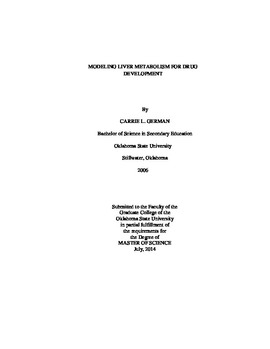| dc.contributor.advisor | Madihally, Sundar V. | |
| dc.contributor.author | German, Carrie L. | |
| dc.date.accessioned | 2015-06-17T20:05:59Z | |
| dc.date.available | 2015-06-17T20:05:59Z | |
| dc.date.issued | 2014-07-01 | |
| dc.identifier.uri | https://hdl.handle.net/11244/14848 | |
| dc.description.abstract | The objective of this study was to evaluate scaffold culture conditions using computational fluid dynamics (CFD) and experimentation for supporting three-dimensional (3D) hepatocyte cultures. I used a CFD software to simulate 3D static bioreactors and two different designs of axial-flow bioreactors to assess the effect of scaffold thickness (0.25mm to 2mm), location within the culture (zero to 1mm), and scaffold porosity (0.25 and 0.85) and compare with experimental results obtained using HepG-2 cells. A 14mm diameter chitosan-gelatin (CG) scaffold (0.85 porosity) prepared by freeze drying of various thicknesses to be placed in a six-well plate was simulated. Simulations were performed at constant cell density and exponential growth in each scaffold thickness. Axial-flow bioreactors were constructed in-house according to the simulated dimensions. Changes in the concentration of three components (oxygen, estrogen and urea) were evaluated using rate constants from literature. Static bioreactors were simulated for 48 h (typical media culture duration) and axial-flow bioreactors were simulated at steady state flow rates ranging from 0.1mL/min to 10 mL/min. Concentrations of all three molecules were affected by placement of the scaffold at 0mm as molecules could not diffuse into the scaffold through the bottom. These results showed that scaffolds thicker than 0.5mm scaffolds in static bioreactors were not capable of supporting three-dimensional liver tissue cultures due to oxygen diffusion limitations. Only oxygen concentration profiles were affected by a further increase in elevation as the static bioreactor was open to the atmosphere and oxygen could diffuse into the media from the air. Simulation results were validated by measuring oxygen consumption and urea production. | |
| dc.format | application/pdf | |
| dc.language | en_US | |
| dc.publisher | Oklahoma State University | |
| dc.rights | Copyright is held by the author who has granted the Oklahoma State University Library the non-exclusive right to share this material in its institutional repository. Contact Digital Library Services at lib-dls@okstate.edu or 405-744-9161 for the permission policy on the use, reproduction or distribution of this material. | |
| dc.title | Modeling Liver Metabolism for Drug Development | |
| dc.type | text | |
| dc.contributor.committeeMember | Foutch, Gary Lynn | |
| dc.contributor.committeeMember | Johannes, Arland J. | |
| osu.filename | German_okstate_0664M_13588.pdf | |
| osu.accesstype | Open Access | |
| dc.description.department | Chemical Engineering | |
| dc.type.genre | Thesis | |
| dc.subject.keywords | axial-flow | |
| dc.subject.keywords | bioreactors | |
| dc.subject.keywords | chitosan-gelatin | |
| dc.subject.keywords | hepatocytes | |
| dc.subject.keywords | hepg2 | |
| dc.subject.keywords | pcl | |
